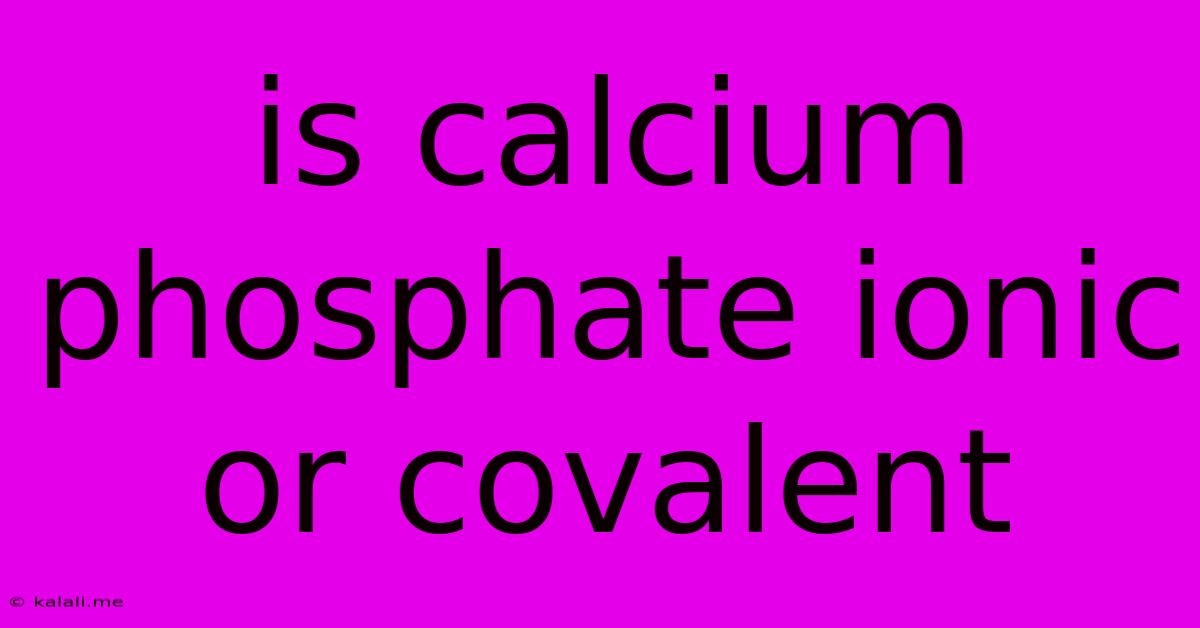Is Calcium Phosphate Ionic Or Covalent
Kalali
Jun 12, 2025 · 3 min read

Table of Contents
Is Calcium Phosphate Ionic or Covalent? Understanding Chemical Bonds
Determining the nature of the bond in calcium phosphate (Ca₃(PO₄)₂) requires understanding the electronegativity differences between the constituent atoms. This article will explore the bonding in calcium phosphate, explaining why it's predominantly ionic, and clarifying the nuances of its chemical structure. Understanding this is crucial for comprehending its properties and applications in various fields, including biology and materials science.
Electronegativity and Bond Types
Chemical bonds arise from the electrostatic attraction between atoms. The type of bond—ionic, covalent, or metallic—depends primarily on the difference in electronegativity between the atoms involved. Electronegativity is a measure of an atom's ability to attract electrons in a chemical bond.
-
Ionic bonds: Form when there's a large difference in electronegativity between atoms. One atom (typically a metal) loses electrons to become a positively charged cation, while the other atom (typically a non-metal) gains electrons to become a negatively charged anion. The electrostatic attraction between these oppositely charged ions creates the ionic bond.
-
Covalent bonds: Form when atoms share electrons, typically between non-metal atoms with similar electronegativities. The shared electrons create a bond that holds the atoms together.
-
Metallic bonds: Found in metals, where electrons are delocalized and shared among many atoms.
Analyzing Calcium Phosphate (Ca₃(PO₄)₂)
Calcium phosphate is composed of calcium (Ca), phosphorus (P), and oxygen (O). Let's examine the electronegativity differences:
- Calcium (Ca): A metal with low electronegativity.
- Phosphorus (P): A non-metal with intermediate electronegativity.
- Oxygen (O): A highly electronegative non-metal.
The significant electronegativity difference between calcium (a metal) and the phosphate group (PO₄³⁻) leads to the formation of ionic bonds between Ca²⁺ cations and (PO₄)³⁻ anions. Within the phosphate group itself, the bonds between phosphorus and oxygen are covalent, although they exhibit some polar character due to the electronegativity difference between P and O. These covalent bonds are strong, contributing to the stability of the phosphate anion.
Therefore, while covalent bonds exist within the phosphate ion, the overall bonding in calcium phosphate is best described as predominantly ionic. The strong electrostatic attraction between the calcium cations and the phosphate anions is the primary force holding the compound together.
Properties Reflecting Ionic Character
The ionic nature of calcium phosphate is reflected in several of its properties:
- High melting point: Ionic compounds generally have high melting points due to the strong electrostatic forces between ions.
- Solubility in polar solvents: Calcium phosphate is soluble in acidic solutions, but its solubility in water is relatively low, which is consistent with many ionic compounds.
- Crystalline structure: Calcium phosphate forms a crystalline structure characterized by a regular arrangement of ions.
Conclusion
In summary, while covalent bonds are present within the phosphate ion (PO₄³⁻), the dominant bonding character in calcium phosphate (Ca₃(PO₄)₂) is ionic. The substantial electronegativity difference between calcium and the phosphate group results in the transfer of electrons and the formation of strong electrostatic interactions between the calcium cations and phosphate anions. This ionic character profoundly influences the physical and chemical properties of calcium phosphate.
Latest Posts
Latest Posts
-
What Is The Electron Configuration Of Argon
Jun 13, 2025
-
Bernoullis Equation Cannot Be Applied When The Flow Is
Jun 13, 2025
-
Adjectives That Start With Letter P
Jun 13, 2025
-
The Planets Closest To The Sun Are Known As The
Jun 13, 2025
-
A Microprocessor Is The Brains Of A Computer
Jun 13, 2025
Related Post
Thank you for visiting our website which covers about Is Calcium Phosphate Ionic Or Covalent . We hope the information provided has been useful to you. Feel free to contact us if you have any questions or need further assistance. See you next time and don't miss to bookmark.